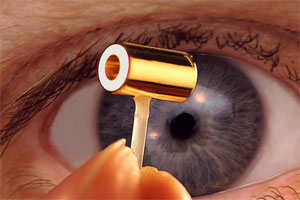 This past Friday, a few thousand folks attended Lawrence Livermore National Laboratory to see dignitaries including California Governor Arnold Schwarzenegger and U.S. Senator Dianne Feinstein dedicated the world's newest and most powerful laser, the National Ignition Facility (NIF).
This past Friday, a few thousand folks attended Lawrence Livermore National Laboratory to see dignitaries including California Governor Arnold Schwarzenegger and U.S. Senator Dianne Feinstein dedicated the world's newest and most powerful laser, the National Ignition Facility (NIF).
Governor Schwarzenegger, clad in a pink tie-- an odd sartorial choice for dedicating this giant hulk of a building housing 500 trillion watt laser housed within-- nevertheless succeeded in channeling at least some of his Hollywood days. When they originally visited the facility last November, "we were so excited that we said, 'We'll be back.'"
The project's goal is to focus 192 laser beams onto a BB-sized capsule of hydrogen fuel in order to heat it to the point of ignition, that is, to achieve a nuclear fusion reaction where more energy comes out of the capsule than is put in. Fusion is the common process for creating energy in the Sun, and has been demonstrated on Earth both in the apocalyptic specter of thermonuclear weapons and in the more hope-inspiring form of plasma reactors such as those at the Joint European Torus (JET) in Britain. However, ignition has yet to be demonstrated, as JET requires a constant influx of energy greater than anything it is capable of producing. If all goes well within the next several months, ignition could be achieved at NIF as early as 2010.
For all of these exciting aspirations and promise of new technology, the press' reaction to NIF throughout the twelve years of its construction has been often lukewarm, and at worst scornful. Some of this has been deserved, and it is certainly true that the facility's $3.5 billion dollar construction cost is a hard price tag to swallow.
However, NIF is a worthy scientific cause and might well turn out to be an excellent investment. To put things a little bit into perspective, other large science projects are similarly expensive. The Large Hadron Collider (LHC) at CERN and the Hubble Space Telescope have both been estimated at about $6 billion. Dianne Feinstein argued in the past (and reminded the audience at Friday's dedication) that Enron needlessly cost $9 billion during the California Energy Crisis. Put another way, with $9 billion you could (a) experience rolling blackouts while Enron power traders cheer for wildfires ravaging your countryside, or (b) assemble the world's most powerful laser and use it to bring the nation to the brink of being able to replicate, in a controlled manner, the sorts of reactions that power the Sun. Twice.
